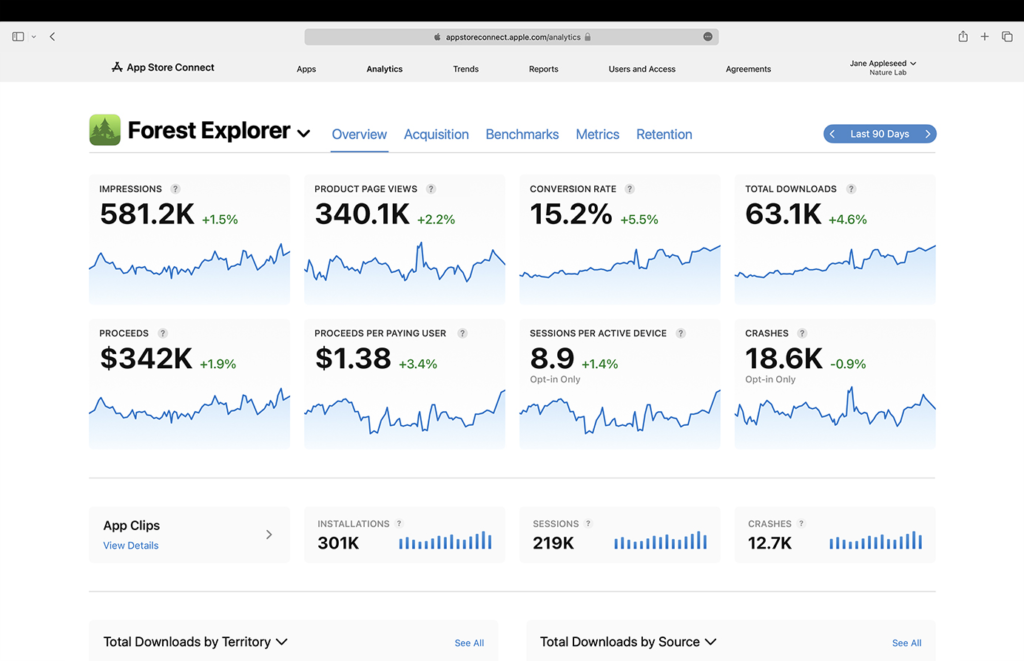Key Takeaways
- Optimize app title, keywords, and description: Tailor metadata with relevant keywords to enhance search visibility and attract potential users.
- Prioritize visual assets: Create eye-catching app icons and screenshots, tailored to resonate with diverse audiences and drive conversions.
- Embrace continuous optimization: Monitor performance metrics, conduct A/B tests, and iterate based on insights to stay competitive and maximize app visibility in the Apple App Store.
In today’s digital landscape, where the competition for app downloads is fiercer than ever, mastering the art of App Store Optimization (ASO) is not just a choice; it’s a necessity.
With millions of apps vying for attention in the Apple App Store, ensuring your app stands out amidst the crowd is crucial for its success.
Welcome to the ultimate guide on Apple App Store ASO – your roadmap to skyrocketing your app’s visibility and driving organic downloads.
ASO is not merely about increasing downloads; it’s about crafting a strategy that enhances your app’s discoverability, drives user engagement, and ultimately boosts your app’s revenue potential.
From optimizing your app’s title, keywords, and description to perfecting its visual assets and managing reviews effectively, every aspect of ASO plays a pivotal role in determining your app’s performance in the App Store rankings.
In this comprehensive guide, we’ll delve deep into the intricate world of Apple App Store ASO, equipping you with the knowledge and strategies needed to navigate through its complexities and emerge victorious.
Whether you’re a seasoned app developer looking to fine-tune your ASO tactics or a newcomer eager to learn the ropes, this guide is tailored to meet your needs, providing actionable insights and best practices every step of the way.
Throughout this journey, we’ll unravel the mysteries behind Apple’s App Store algorithms, decode the secrets to crafting an irresistible app title, and unveil the power of compelling visuals in driving conversions.
We’ll explore the nuances of app reviews and ratings management, share expert tips on localization and regional optimization, and delve into the realm of A/B testing and continuous optimization for sustained success.
But our journey doesn’t stop there.
We’ll equip you with the tools and techniques needed to monitor and analyze your ASO performance effectively, empowering you to make data-driven decisions and fine-tune your strategies for optimal results.
Whether you’re aiming to climb the ranks in search results, increase app downloads, or improve user retention rates, this guide has got you covered.
So, buckle up and get ready to embark on a transformative journey towards unlocking the full potential of your app in the Apple App Store.
Whether you’re dreaming of reaching the coveted #1 spot or simply aiming to enhance your app’s visibility and reach, the insights and strategies shared in this guide will pave the way for your success.
It’s time to take charge of your app’s destiny and propel it to new heights of greatness through the power of Apple App Store ASO. Let’s dive in.
Before we venture further, we like to share who we are and our digital experiences.
About AppLabx
From developing a solid marketing plan to creating compelling content, optimizing for search engines, leveraging social media, and utilizing paid advertising, AppLabx offers a comprehensive suite of digital marketing services designed to drive growth and profitability for your business.
AppLabx is well known for helping companies and startups use ASO to drive traffic to their websites and web apps.
At AppLabx, we understand that no two businesses are alike. That’s why we take a personalized approach to every project, working closely with our clients to understand their unique needs and goals, and developing customized strategies to help them achieve success.
If you need a digital consultation, then send in an inquiry here.
Apple App Store ASO: The Ultimate Guide to Boost Your App’s Visibility
- Understanding Apple App Store Algorithms
- App Title, Keywords, and Description Optimization
- App Icon and Screenshots Optimization
- App Reviews and Ratings Management
- Localization and Regional Optimization
- App Store A/B Testing and Continuous Optimization
- Monitoring and Analyzing Performance
1. Understanding Apple App Store Algorithms
Introduction to Apple App Store Algorithms
- The Apple App Store employs sophisticated algorithms to rank apps in search results and category listings.
- These algorithms consider various factors to determine the relevance and quality of apps, ultimately influencing their visibility to users.

Key Factors Influencing App Ranking
- App Title and Keywords
- The app title and keywords play a crucial role in determining its relevance to user searches.
- Including relevant keywords in the title and metadata can significantly improve the app’s visibility.
- For example, a fitness app titled “Workout Trainer – Fitness & Exercise App” effectively incorporates relevant keywords to target users searching for fitness-related apps.
- App Description and Metadata
- The app description provides an opportunity to further optimize for relevant keywords and communicate the app’s value proposition.
- Including keywords naturally within the app description can improve its discoverability.
- For instance, a productivity app description that highlights features like task management, calendar integration, and collaboration tools can attract users searching for productivity solutions.
- App Reviews and Ratings
- User reviews and ratings are important signals of app quality and user satisfaction.
- Apps with higher ratings and positive reviews tend to rank higher in search results.
- Encouraging satisfied users to leave positive reviews and promptly addressing any negative feedback can improve the app’s overall rating and visibility.
- App Downloads and Engagement
- The number of app downloads and user engagement metrics, such as retention rate and session duration, are factors considered by the algorithm.
- Apps with a high download volume and active user base are more likely to rank higher in search results.
- Offering incentives for users to download the app, such as limited-time promotions or exclusive features, can help boost download numbers and engagement.
Insights into Recent Algorithm Changes
- The Apple App Store algorithm undergoes periodic updates to improve user experience and ensure fairness in app rankings.
- Recent changes have placed greater emphasis on user engagement metrics and app quality indicators.
- For example, the introduction of App Store Connect features like App Analytics provides developers with deeper insights into user behavior and app performance, allowing them to optimize their apps accordingly.

- Understanding the intricacies of the Apple App Store algorithms is essential for optimizing app visibility and driving organic downloads.
- By focusing on key factors such as app title, keywords, description, reviews, and engagement metrics, developers can improve their app’s chances of ranking higher in search results and attracting more users.
- Keeping abreast of recent algorithm changes and leveraging available tools and resources can further enhance the effectiveness of ASO strategies in the ever-evolving landscape of the App Store.
2. App Title, Keywords, and Description Optimization
Importance of App Title, Keywords, and Description
- The app title, keywords, and description are critical components of App Store Optimization (ASO), directly impacting the app’s discoverability and visibility.
- Optimizing these elements ensures that the app ranks higher in relevant searches and attracts potential users’ attention.

Crafting an Effective App Title
- Incorporate Relevant Keywords
- Include primary keywords that accurately describe the app’s purpose and functionality.
- Choose keywords that have high search volume and low competition to maximize visibility.
- For example, a weather forecasting app could have a title like “WeatherCast: Accurate Weather Forecasts & Radar Maps.”
- Keep it Concise and Memorable
- The app title should be concise and easy to remember, making it more likely for users to recall and search for it.
- Avoid lengthy titles that may get truncated in search results or app listings.
- For instance, “TaskMaster: To-Do List & Reminder” effectively conveys the app’s purpose in a short and memorable title.
Selecting Relevant Keywords
- Research Keyword Trends
- Conduct thorough keyword research to identify popular search terms relevant to the app’s niche.
- Utilize keyword research tools and analyze competitor apps to uncover valuable keyword opportunities.
- For example, a photo editing app may target keywords like “photo editor,” “photo filters,” and “image enhancement.”
- Prioritize Long-Tail Keywords
- Long-tail keywords are more specific and have lower competition, making it easier to rank for them.
- Target long-tail keywords that align with the app’s unique features and functionalities.
- For instance, a recipe app could include long-tail keywords like “easy vegan dinner recipes” or “healthy gluten-free desserts.”
Crafting an Optimized App Description
- Highlight Key Features and Benefits
- The app description should succinctly highlight the app’s key features, benefits, and unique selling points.
- Clearly communicate how the app solves users’ problems or fulfills their needs.
- For example, a language learning app description could emphasize features like interactive lessons, personalized learning plans, and progress tracking.
- Incorporate Keywords Naturally
- Integrate relevant keywords organically throughout the app description to improve search visibility.
- Avoid keyword stuffing, as it can negatively impact readability and user experience.
- For instance, instead of repeating keywords excessively, focus on crafting descriptive sentences that naturally include relevant keywords.
Example of Effective Optimization
- App Title: “RecipePal: Easy Meal Planner & Grocery List”
- Keywords: “meal planner,” “grocery list,” “recipe organizer,” “meal prep,” “cooking app”
- Description: “Simplify meal planning with RecipePal, the ultimate meal planner and grocery list app. Plan your weekly meals, discover new recipes, and create shopping lists with ease. With features like recipe organization, customizable meal plans, and smart grocery suggestions, cooking nutritious meals has never been easier. Download RecipePal now and revolutionize the way you meal prep!”
Summary
- Optimizing the app title, keywords, and description is essential for improving the app’s visibility and attracting potential users.
- By incorporating relevant keywords, crafting compelling titles, and highlighting key features in the description, developers can enhance their app’s chances of ranking higher in search results and driving organic downloads.
- Continuous monitoring and refinement of these elements based on user feedback and performance metrics are crucial for maintaining competitiveness in the ever-evolving landscape of the app store.
3. App Icon and Screenshots Optimization
Importance of App Icon and Screenshots
- The app icon and screenshots are the first visual elements that users encounter when browsing the app store.
- Optimizing these assets is crucial for capturing users’ attention, conveying the app’s value proposition, and driving downloads.
Designing an Eye-Catching App Icon
- Simple and Recognizable Design
- Create an app icon with a clean and recognizable design that reflects the app’s brand and purpose.
- Avoid cluttered or overly complex designs that may be difficult to discern at smaller sizes.
- For example, the Twitter app icon features a simple blue bird silhouette, instantly recognizable to users.
- Consistency with Branding
- Ensure that the app icon aligns with the overall branding and visual identity of the app.
- Use consistent colors, typography, and design elements to reinforce brand recognition.
- For instance, the Spotify app icon incorporates the brand’s signature green color and distinctive logo.

Crafting Engaging Screenshots
- Showcase Key Features and Benefits
- Use screenshots to highlight the app’s key features, functionality, and user experience.
- Include screenshots of different app screens to provide a comprehensive overview.
- For example, a productivity app could showcase screenshots of task lists, calendar views, and collaboration features.
- Tell a Story with Screenshots
- Arrange screenshots in a sequence that tells a compelling story or demonstrates the app’s workflow.
- Use captions or annotations to guide users through the screenshots and highlight important features.
- For instance, a fitness app could use screenshots to showcase workout routines, progress tracking, and achievements.
Optimizing for Different Screen Sizes
- Ensure Compatibility Across Devices
- Design app icons and screenshots that are optimized for various screen sizes and resolutions.
- Test the visuals on different devices to ensure they display properly and maintain clarity.
- For example, ensure that the app icon remains recognizable on both smartphones and tablets.
- Utilize App Store Connect Features
- Take advantage of App Store Connect’s app preview tool to create engaging videos that showcase the app in action.
- Use app previews to provide users with a dynamic preview of the app’s features and functionality.
- For instance, a gaming app could use app previews to showcase gameplay footage and highlight exciting game mechanics.
Example of Effective Optimization
- App Icon: A meditation app could feature a calming image, such as a lotus flower or a serene landscape, to convey relaxation and tranquility.
- Screenshots: Showcase different meditation sessions, meditation techniques, and personalized features like progress tracking and meditation reminders.
Summary
- Optimizing the app icon and screenshots is essential for capturing users’ attention and conveying the app’s value proposition effectively.
- By designing a simple yet recognizable app icon, crafting engaging screenshots that showcase key features and benefits, and optimizing for different screen sizes, developers can improve their app’s chances of standing out in the crowded app store marketplace.
- Continuous testing, iteration, and refinement of these visual assets based on user feedback and performance metrics are key to maintaining competitiveness and driving downloads.
4. App Reviews and Ratings Management
Importance of App Reviews and Ratings
- App reviews and ratings play a crucial role in shaping users’ perceptions of an app and influencing their download decisions.
- Managing app reviews and ratings effectively is essential for maintaining a positive reputation, improving user trust, and increasing app visibility in the app store.
Encouraging Positive Reviews
- Prompt Users to Leave Reviews
- Strategically prompt users to leave reviews at key moments within the app, such as after completing a task or achieving a milestone.
- Use non-intrusive pop-up messages or in-app prompts to encourage users to share their feedback.
- For example, a productivity app could prompt users to leave a review after successfully completing a task or reaching a productivity milestone.
- Offer Incentives for Reviews
- Provide incentives, such as in-app rewards or discounts, to users who leave positive reviews.
- Make sure to comply with app store guidelines and avoid offering incentives in exchange for positive reviews.
- For instance, a mobile game could offer bonus coins or exclusive in-game items to players who leave a review.

Addressing Negative Reviews
- Respond Promptly and Professionally
- Monitor app reviews regularly and respond promptly to any negative feedback or complaints.
- Acknowledge the user’s concerns, apologize for any issues experienced, and offer solutions or assistance.
- For example, a customer service app could respond to a negative review by offering to troubleshoot the user’s issue or providing additional support.
- Implement Feedback for Improvement
- Use negative reviews as an opportunity for learning and improvement.
- Identify common pain points or areas for enhancement mentioned in negative reviews and prioritize addressing them in future updates.
- For instance, if users frequently complain about a bug or usability issue, prioritize fixing it in the next app update.
Leveraging Positive Reviews for Promotion
- Feature Positive Reviews in App Store Listing
- Showcase positive reviews and testimonials in the app store listing to build credibility and trust with potential users.
- Highlight specific features or benefits mentioned in positive reviews to entice users to download the app.
- For example, a language learning app could include excerpts from positive reviews praising its effectiveness and ease of use.
- Share Positive Reviews on Social Media and Marketing Materials
- Share positive reviews and user testimonials on social media platforms and marketing materials to amplify their impact.
- Use quotes or screenshots from positive reviews to create compelling social media posts or promotional graphics.
- For instance, a fitness app could share success stories and testimonials from satisfied users on its Instagram or Facebook page.
Example of Effective Reviews Management
- Prompt Users to Leave Reviews: A food delivery app prompts users to leave a review after completing a successful order, offering a discount on their next purchase as an incentive.
- Responding to Negative Reviews: A ride-sharing app responds to a user’s complaint about a late driver by apologizing for the inconvenience and offering a credit for their next ride as a gesture of goodwill.
Summary
- App reviews and ratings are valuable indicators of an app’s quality and user satisfaction, influencing its visibility and download rates.
- By encouraging positive reviews, addressing negative feedback promptly and professionally, and leveraging positive reviews for promotion, developers can effectively manage app reviews and ratings to enhance their app’s reputation and success in the app store.
- Continuous monitoring and engagement with user feedback are essential for maintaining a positive relationship with users and driving ongoing improvements to the app.
5. Localization and Regional Optimization
Importance of Localization
- Localization involves adapting the app to meet the linguistic, cultural, and functional requirements of different target markets.
- Implementing localization strategies is crucial for expanding the app’s global reach, enhancing user engagement, and maximizing revenue potential.
Tailoring App Metadata for Different Regions
- Translate App Title and Description
- Translate the app title, description, and other metadata into the language(s) spoken in the target market.
- Ensure that the translated content accurately conveys the app’s value proposition and features.
- For example, a language learning app could provide translations in multiple languages to cater to users worldwide.
- Adjust Keywords for Local Search Trends
- Conduct keyword research specific to each target market to identify relevant search terms and phrases.
- Incorporate localized keywords into the app’s metadata to improve its visibility in local app store searches.
- For instance, a travel app targeting users in Japan may use keywords like “旅行アプリ” (travel app) or “ホテル予約” (hotel reservation) to optimize for Japanese users’ search queries.

Cultural Adaptation of Visual Assets
- Customize App Icons and Screenshots
- Adapt app icons and screenshots to reflect cultural preferences and sensitivities in different regions.
- Use images, colors, and symbols that resonate with the target audience and convey the app’s purpose effectively.
- For example, a fitness app may use culturally diverse imagery and icons to appeal to users from various backgrounds.
- Localize Visual Content and Messaging
- Customize visual content and messaging to align with cultural norms, holidays, and traditions.
- Avoid using images or language that may be considered offensive or inappropriate in certain cultures.
- For instance, a food delivery app may feature images of popular local dishes and use culturally relevant messaging to attract users in different regions.
Adhering to Legal and Regulatory Requirements
- Compliance with Regional Laws and Regulations
- Ensure that the app complies with local laws, regulations, and industry standards in each target market.
- Adapt features, content, and policies to meet specific legal requirements related to data privacy, consumer protection, and content moderation.
- For example, an e-commerce app operating in the European Union would need to comply with the General Data Protection Regulation (GDPR) and provide users with transparent data protection practices.
- Localized Payment and Pricing Options
- Offer localized payment methods and pricing options to accommodate regional preferences and payment habits.
- Support popular payment gateways, currencies, and pricing models to facilitate seamless transactions for users worldwide.
- For instance, a subscription-based app may offer different pricing tiers and payment options based on the user’s location and currency preferences.
Example of Effective Localization
- Translation of App Metadata: A meditation app translates its app title, description, and keywords into multiple languages, including Spanish, French, and German, to attract users from diverse linguistic backgrounds.
- Cultural Adaptation of Visual Assets: A travel app customizes its app icon and screenshots to feature iconic landmarks and landscapes from different regions, appealing to users’ wanderlust and cultural interests.
Summary
- Localization and regional optimization are essential strategies for maximizing the app’s global reach and relevance in diverse markets.
- By tailoring app metadata, visual assets, and features to meet the linguistic, cultural, and regulatory needs of each target market, developers can enhance user engagement, drive app adoption, and establish a strong presence worldwide.
- Continuous monitoring of regional trends, user feedback, and market dynamics is key to maintaining a competitive edge and ensuring ongoing success in the global app marketplace.
6. App Store A/B Testing and Continuous Optimization
Introduction to A/B Testing and Optimization
- A/B testing, also known as split testing, involves comparing two versions of a marketing asset or feature to determine which one performs better.
- Continuous optimization involves ongoing testing, analysis, and refinement of app store elements to improve conversion rates, user engagement, and overall performance.

Identifying Testable Elements
- App Icon and Visual Assets
- Test variations of the app icon, screenshots, and promotional graphics to determine which designs resonate best with users.
- Experiment with different colors, layouts, and messaging to optimize visual appeal and conversion rates.
- For example, a dating app may test different variations of its app icon featuring different color schemes or imagery to gauge user preferences.
- App Title and Description
- Conduct A/B tests on the app title, description, and keywords to optimize for search visibility and user engagement.
- Test variations of the app title to determine which keywords drive the highest click-through rates and conversions.
- For instance, a language learning app may test different combinations of keywords in the app title to identify the most effective ones for attracting users.
Implementing A/B Tests
- Define Hypotheses and Objectives
- Clearly define the hypotheses and objectives of each A/B test to ensure meaningful results.
- Identify key performance indicators (KPIs) such as conversion rate, click-through rate, or app store ranking to measure success.
- For example, a music streaming app may hypothesize that a more personalized app description will lead to higher conversion rates among users interested in specific music genres.
- Use A/B Testing Tools and Platforms
- Utilize A/B testing tools and platforms specifically designed for app store optimization to conduct experiments effectively.
- Choose tools that offer robust analytics, segmentation capabilities, and easy implementation of test variations.
- For instance, platforms like StoreMaven and SplitMetrics enable developers to run A/B tests on app store elements such as screenshots, icons, and descriptions.
Analyzing Results and Iterating
- Monitor and Analyze Performance Metrics
- Monitor the performance of A/B test variations in real-time and track relevant performance metrics.
- Analyze quantitative data such as conversion rates, downloads, and user engagement metrics to evaluate test outcomes.
- For example, a productivity app may analyze download and retention rates to determine the impact of different app icon designs on user acquisition and retention.
- Iterate Based on Insights
- Use insights from A/B test results to inform iterative improvements and refinements to app store elements.
- Implement changes based on successful test variations and discard ineffective elements.
- For instance, if an A/B test reveals that a certain screenshot variation leads to higher conversion rates, the app developer may permanently update the app store listing with that design.
Example of A/B Testing and Optimization
- A/B Testing App Icons: A fitness app conducts A/B tests on different variations of its app icon, measuring download conversion rates for each design. After analyzing the results, the app developer identifies the most effective icon design and implements it permanently in the app store listing.
Summary
- A/B testing and continuous optimization are essential strategies for improving app store visibility, conversion rates, and user engagement.
- By systematically testing and refining app store elements such as icons, screenshots, titles, and descriptions, developers can identify the most effective strategies for attracting users and driving downloads.
- Continuous monitoring, analysis, and iteration based on A/B test results enable developers to stay competitive in the dynamic landscape of the app store and maximize the success of their apps.
7. Monitoring and Analyzing Performance
Introduction to Performance Monitoring
- Monitoring and analyzing app performance metrics are crucial for evaluating the effectiveness of ASO strategies and identifying areas for improvement.
- By tracking key performance indicators (KPIs) and user engagement metrics, developers can make informed decisions to optimize app store visibility and drive downloads.
Tracking Key Performance Indicators (KPIs)
- App Store Ranking
- Monitor the app’s ranking in relevant app store categories and search results.
- Track changes in app store ranking over time to assess the impact of ASO efforts.
- For example, a gaming app may track its ranking in the “Top Free Games” category to evaluate its visibility and competitiveness.
- Conversion Rate
- Measure the conversion rate of app store visitors to downloads.
- Analyze the effectiveness of app store elements such as icons, screenshots, titles, and descriptions in driving conversions.
- For instance, an e-commerce app may track the conversion rate of users who visit the app store listing to those who download the app.

Analyzing User Engagement Metrics
- Downloads and Installations
- Monitor the number of downloads and installations of the app over time.
- Track download trends and patterns to identify peak periods of user acquisition.
- For example, a social media app may analyze download spikes after the release of new features or marketing campaigns.
- Retention Rate
- Measure the percentage of users who continue to use the app over time.
- Analyze retention rates by cohort to identify trends and patterns among different user segments.
- For instance, a fitness app may track user retention rates for users who complete a workout program versus those who do not.
Utilizing App Store Analytics Tools
- App Store Connect
- Utilize the analytics dashboard in App Store Connect to access comprehensive performance data.
- Monitor metrics such as app store impressions, product page views, and app units to understand user behavior.
- For example, an educational app developer may use App Store Connect to track user engagement with app preview videos and screenshots.
- Third-Party Analytics Platforms
- Leverage third-party analytics platforms such as Firebase, Google Analytics, or Mixpanel for in-depth analysis of app performance.
- Use advanced analytics features to track user behavior, engagement metrics, and conversion funnels.
- For instance, a productivity app may use Google Analytics to analyze user interactions within the app and identify areas for improvement.
Iterating Based on Insights
- Identify Strengths and Weaknesses
- Analyze performance metrics to identify areas of strength and weakness in the app store optimization strategy.
- Determine which app store elements are driving the highest conversion rates and which ones may need improvement.
- For example, an entertainment app developer may discover that a particular screenshot variation is performing exceptionally well and decide to iterate on similar designs.
- Implement Iterative Improvements
- Based on insights from performance analysis, implement iterative improvements to app store elements.
- Continuously test and refine app store assets such as icons, screenshots, titles, and descriptions to optimize for conversion and engagement.
- For instance, a travel app developer may update the app title and description based on keyword performance data to improve search visibility and downloads.
Example of Performance Monitoring and Analysis
- App Store Ranking Analysis: A language learning app tracks its ranking in the “Education” category on the App Store and notices a drop in ranking after updating the app description. After reverting the changes, the app’s ranking improves, highlighting the importance of optimizing app store elements for visibility.
Summary
- Monitoring and analyzing app performance metrics are essential practices for evaluating the effectiveness of ASO strategies and driving continuous improvement.
- By tracking key performance indicators such as app store ranking, conversion rate, downloads, retention rate, and user engagement metrics, developers can gain valuable insights into user behavior and optimize app store elements accordingly.
- Leveraging app store analytics tools and implementing iterative improvements based on performance analysis enable developers to stay competitive in the app store marketplace and maximize the success of their apps.
Conclusion
Mastering Apple App Store ASO is a journey that requires dedication, strategy, and continuous refinement.
Throughout this ultimate guide, we’ve explored the intricacies of ASO and provided comprehensive insights and strategies to boost your app’s visibility and drive organic downloads in the highly competitive landscape of the Apple App Store.
From understanding the algorithms that influence app rankings to optimizing app title, keywords, and description, every aspect of ASO plays a crucial role in determining your app’s success.
By leveraging localization and regional optimization, developers can expand their app’s global reach and cater to diverse audiences with tailored app store assets.
App reviews and ratings management are essential for maintaining a positive reputation and fostering user trust, while A/B testing and continuous optimization enable developers to iterate on app store elements and improve conversion rates over time.
Monitoring and analyzing app performance metrics provide valuable insights into user behavior and guide iterative improvements to ASO strategies.
Ultimately, the journey to boosting your app’s visibility in the Apple App Store is an ongoing process.
By staying informed about the latest trends and best practices in ASO, continuously testing and refining app store elements, and adapting to evolving user preferences and market dynamics, developers can position their apps for success and maximize their impact on a global scale.
In a rapidly evolving digital landscape, the ultimate guide to Apple App Store ASO serves as a roadmap for developers seeking to unlock the full potential of their apps and thrive in the competitive app store marketplace.
By implementing the strategies outlined in this guide and embracing a data-driven approach to ASO, developers can elevate their apps to new heights of visibility, engagement, and success in the Apple App Store and beyond.
If you are looking for a top-class digital marketer, then book a free consultation slot here.
If you find this article useful, why not share it with your friends and business partners, and also leave a nice comment below?
We, at the AppLabx Research Team, strive to bring the latest and most meaningful data, guides, and statistics to your doorstep.
To get access to top-quality guides, click over to the AppLabx Blog.
People also ask
How does App Store Optimization (ASO) impact app visibility?
ASO improves app visibility by optimizing metadata like titles, keywords, and descriptions to rank higher in search results, increasing chances of discovery.
What are the key elements to optimize in the Apple App Store?
Optimize app title, keywords, description, and visual assets like icons and screenshots to maximize visibility and attract potential users effectively.
Why is it essential to localize app store elements?
Localization ensures app store elements are tailored to different regions, languages, and cultures, enhancing user experience and driving downloads globally.
How can app reviews and ratings influence app visibility?
Positive reviews and high ratings improve app credibility and increase its visibility in search results, attracting more users and driving organic downloads.
What role does continuous optimization play in ASO?
Continuous optimization involves monitoring performance metrics, conducting A/B tests, and iterating based on insights to maintain competitiveness and maximize app visibility.
How can A/B testing improve app store performance?
A/B testing compares variations of app store elements like icons and descriptions to identify the most effective strategies for driving conversions and increasing visibility.
What metrics should I track to measure ASO effectiveness?
Track metrics like app store ranking, conversion rate, downloads, retention rate, and user engagement to evaluate ASO strategies and optimize app performance.
How does regional optimization impact app visibility?
Regional optimization tailors app store elements to specific regions, languages, and cultural preferences, increasing relevance and visibility in local markets.
What are the best practices for optimizing app icons?
Design simple, recognizable app icons that reflect the app’s brand and purpose, ensuring clarity and appeal across various devices and screen sizes.
How can I encourage users to leave positive reviews?
Prompt users to leave reviews within the app, offer incentives for positive reviews, and respond promptly and professionally to negative feedback to encourage positive reviews.
What are the benefits of optimizing app screenshots?
Optimized screenshots showcase key app features and benefits, entice users to download the app, and improve conversion rates by providing visual context and compelling imagery.
How does keyword optimization impact app visibility?
Keyword optimization involves incorporating relevant keywords into app metadata to improve search visibility and attract users searching for specific terms or phrases.
What strategies can I use to improve app store conversion rates?
Improve app store conversion rates by optimizing visual assets, crafting compelling descriptions, using persuasive calls-to-action, and leveraging positive reviews and ratings.
How does app store ranking affect app visibility?
Apps with higher rankings appear at the top of search results and category listings, increasing visibility and attracting more users, resulting in higher download rates.
How can I leverage localization to drive downloads in different markets?
Leverage localization by translating app metadata, adapting visual assets, and complying with regional laws and regulations to enhance relevance and appeal in diverse markets.
What tools can I use for app store analytics and performance monitoring?
Utilize tools like App Store Connect, Google Analytics, Firebase, and third-party A/B testing platforms to track app performance metrics, analyze user behavior, and optimize ASO strategies.
How can I optimize app descriptions for maximum impact?
Craft concise, informative app descriptions that highlight key features, benefits, and value propositions, incorporating relevant keywords naturally to improve search visibility.
What are the best practices for responding to negative reviews?
Respond promptly and professionally to negative reviews, acknowledge user concerns, offer solutions or assistance, and use feedback to identify areas for improvement and optimization.
How do app updates impact app store visibility?
Regular app updates signal to users and app store algorithms that the app is actively maintained and improved, potentially boosting visibility and attracting more downloads.
How can I stay updated on ASO trends and best practices?
Stay updated on ASO trends and best practices by following industry blogs, attending conferences and webinars, participating in online communities, and experimenting with new strategies.
How do I choose the right keywords for app optimization?
Choose relevant keywords with high search volume and low competition, focusing on terms that accurately describe the app’s purpose, features, and target audience to maximize visibility.
What are the benefits of conducting A/B tests for app store elements?
A/B tests help identify the most effective app store elements for driving conversions, increasing visibility, and optimizing user engagement, leading to improved app performance overall.
How does app store optimization contribute to user acquisition?
App store optimization improves app discoverability, increases search visibility, and enhances user engagement, ultimately driving more organic downloads and user acquisition.
How can I improve app store conversion rates without changing the app itself?
Optimize app store elements like icons, screenshots, titles, and descriptions to improve conversion rates without altering the app itself, leveraging visual appeal and persuasive messaging.
What are the common pitfalls to avoid in app store optimization?
Avoid common pitfalls in app store optimization, such as keyword stuffing, neglecting localization, ignoring user feedback, and failing to stay updated on industry trends and best practices.
How can I leverage user feedback to optimize app performance?
Use user feedback to identify areas for improvement, prioritize feature updates, and refine app store elements, ensuring that the app meets user needs and preferences effectively.
What role do app previews play in driving app store conversions?
App previews provide users with a dynamic preview of the app’s features and functionality, increasing engagement and conversion rates by providing visual context and showcasing app benefits.
How can I optimize app store assets for better search visibility?
Optimize app store assets by incorporating relevant keywords into titles, descriptions, and metadata, choosing high-quality visuals, and maintaining consistency with app branding to improve search visibility.
What strategies can I use to increase app store conversion rates over time?
Increase app store conversion rates over time by continuously monitoring performance metrics, conducting A/B tests, iterating based on insights, and staying updated on ASO trends and best practices.




































